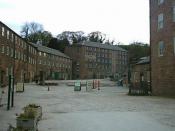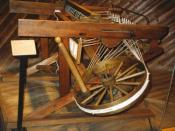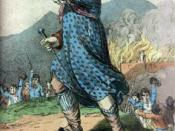During the 18th century, England's colonies provided a market for manufactured products. The manufacture and export of various cloths were essential to the English economy at this time. Before the Industrial Revolution, materials were produced under the putting-out system, in which merchant clothiers had there work done in the homes of artisans or farming families. This was called the "cottage industry." Production was limited by the dependence on the spinning wheel and the handloom, due to the fact that increases in output required more hand workers at each stage.
In the early 1700s, there was great demand for cotton cloth. The demand for cloth was so great that people could not supply enough cloth to satisfy demand. Invention dramatically changed the nature of material work. In 1733 John Kay invented the Flying Shuttle, which made weaving much faster. It was still a hand process, not a mechanized one, but the weaver could work more quickly and the cloth could be made much wider.
This was a device that resulted in greater production from a single loom, cloth of greater width, and reduced the need for as many people to tend the looms. Redesigning the mechanism, which feeds out the weft, which is the thread that crosses the warp, did this. Kay's device became immediately unpopular with weavers because of their fear of becoming unemployed. In 1755 he was attacked by a mob that destroyed one of his looms. He died an impoverished man in 1764, although his flying shuttle was used widely after his death. The later invention of powered looms was made possible only by his invention.
The flying shuttle was a machine that reduced weaving time by half. Now, there was a new problem as there was an insufficient supply of yarn. This problem was solved by the...


